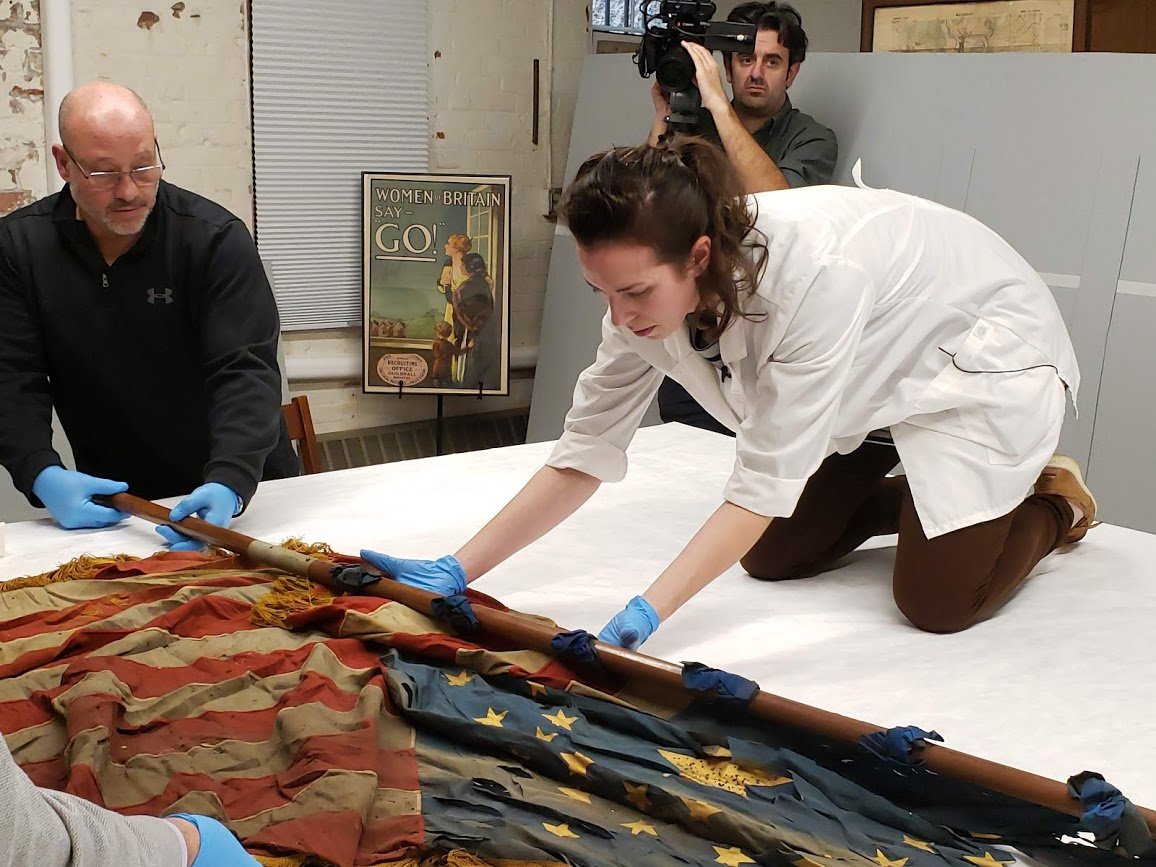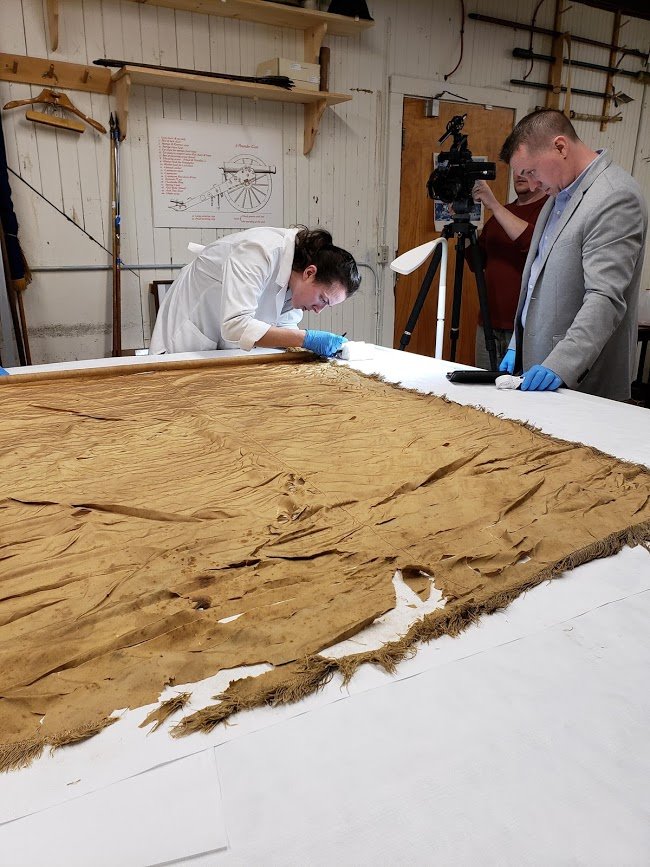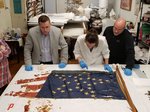- FRIDAY, JULY 26, 2024
Bristol owns America’s oldest flag
The Nathaniel Byfield flag, long forgotten in a Burnside Building case, is thought to be the oldest Colonial American flag in existence
Fresh off her debut as a Fourth of July question on “Jeopardy,” Bristol is once again flexing her patriotic chops as the owner of the Nathaniel Byfield flag. Dating to about 1690, the …
This item is available in full to subscribers.
Please log in to continue |
Register to post eventsIf you'd like to post an event to our calendar, you can create a free account by clicking here. Note that free accounts do not have access to our subscriber-only content. |
Day pass subscribers
Are you a day pass subscriber who needs to log in? Click here to continue.
Bristol owns America’s oldest flag
The Nathaniel Byfield flag, long forgotten in a Burnside Building case, is thought to be the oldest Colonial American flag in existence
Fresh off her debut as a Fourth of July question on “Jeopardy,” Bristol is once again flexing her patriotic chops as the owner of the Nathaniel Byfield flag. Dating to about 1690, the flag would be the oldest surviving banner from the Colonial period.
The flag was found bundled with several others in a massive flag case in the Burnside Building on Hope Street. The second floor of the building once served as a repository of the Town’s historical artifacts, and at some point, a massive floor-to-ceiling case was built to house the flags that were used every year for events such as Memorial Day and July 4 observances.
“The flags were probably there from the time the Burnside building was built in 1883,” said former Town Clerk Lou Cirillo. “I was always told the case contained General Burnside memorabilia.” Burnside memorabilia would have dated from the Civil War — historic to be sure — but the case was to reveal something far older.
According to Mr. Cirillo, in the 1930s, Alice Bateman Almy and a few other residents formed a group to fix up the exhibits. The Bristol Historical and Preservation Society was formed out of this group, with Ms. Almy as its first curator. The town said they could have the contents of the collection stored in the Burnside Building, but the flag case was huge and there was no practical way to move it, so there it remained, and the flags were left behind.
The flags were last known to be moved during the administration of Joe Parella (1994-2004), who had the case refurbished. It was then that the flags were wrapped in plastic and placed back in the case.
“We knew we had some old Civil War flags in there that we should do something with, but we knew it would cost a fortune and there were so many other priorities,” said Mr. Cirillo. One day he received a call from someone who wanted to see the memorial on the second floor of the Burnside Building engraved with the names of Bristol residents who served in the Civil War. He asked about the contents of the flag case, and when Mr. Cirillo told him what he thought was in there, the man said he knew someone who might be interested.
Curator, conservators of military history
Patrick Donovan is the director of the Varnum Armory, a rising star of a military history museum; Maria Vazquez is an expert textile conservator. They were indeed interested in the contents of Bristol’s flag case. In 2019, not long after being put in touch with Mr. Cirillo, Mr. Donovan and Ms. Vazquez came to Bristol and, with Mr. Cirillo, peeled back the plastic to get a better look. A few things soon became clear: Bristol had flags that might have been carried in battle during the Civil War, there was another flag significantly older than that, and the flags were in terrible shape.
Mr. Donovan, acting on behalf of the Varnum Armory, made a proposal to the Town of Bristol that was, after some negotiation, formalized in December 2019. They offered to investigate, conserve and display the historic flags at their East Greenwich museum.
When he first submitted the proposal to Bristol, Mr. Donovan was unsure of what they had, but said they were very encouraged by a glimpse of the first flag. Though only the left edge of the flag was visible, it appeared to be the Headquarters flag of the 9th Corps of the Union Army of the Potomac, a unit founded by and at times led by General Ambrose Burnside during the Civil War. The 9th Corps participated in some of the most epic and critical battles and campaigns of the war, including Burnside’s North Carolina Expedition, Antietam, Fredericksburg, Vicksburg, The Overland Campaign, Petersburg and more.
“This flag, if it exists, would be a national and certainly a State treasure deserving of proper conservation and display to the public,” wrote Mr. Donovan in his 2019 proposal. “This would be a great opportunity for the Town of Bristol to play a proactive role in saving our history; a part of our history that we should all be proud of in that it brought the sad and ugly institution of slavery to an end.”
Several of the other flags were in very poor condition, their silk badly shattered or in the process of shattering, meaning the silk fabric is very brittle and breaks into pieces — even dust or powder if deterioration goes far enough.
The shattering of the silk stopped the unfurling of the flags at the Town Hall for fear of causing more damage, so Mr. Donovan proposed bringing the flags on the poles still wrapped to the place where conservation work would be performed and unwrap them there.
Mr. Donovan proposed that he would project manage, and, through the Varnum Armory, pay for the conservation of any flags deemed worthy, with close cooperation and oversight from Bristol, and the conservation work to be performed by Ms. Vazquez’ company, Royal Conservation Inc. The work would be performed at the Varnum Armory.
Given the large investment of time and money, Mr. Donovan asked the Town of Bristol to allow any of the conserved flags to be put on a long-term display at the Varnum Armory Museum, which houses the world’s largest collection of Rhode Island military history. The Town of Bristol would retain ownership, and the Varnum Armory would allow the Town of Bristol to borrow and display the flags for special events.
Bristol’s flags move to East Greenwich
“I have to give Louis (Cirillo) credit,” said Town Administrator Steven Contente. “I didn’t know anything about the Varnum Armory, and my first reaction was that we weren’t giving our flags away, but he told me not to be short sighted … We had these very valuable historic artifacts and we don’t have the capacity to restore and properly display them, and there’s a place here in Rhode Island with the knowledge and ability to restore and care for these items at no cost to the town.”
“The deal is, they preserve and display, keep us updated on their condition and seek approval for any other uses, and we can have them up to 90 days a year if we wanted to have them in town for special events.”
“When Maria and I went in 2019 and started to unfurl the flags, you could tell immediately they were 19th century. They were weighted with metal, very brittle, and we had to stop,” said Mr. Donovan.
“We brought the flags to the Armory and built a humidification chamber, and the flags spent two weeks in there. Then we spent a whole day unfurling.”
An unexpected surprise
“They were mostly Civil War flags and veterans flags,” said Mr. Donovan. “That’s still neat — but then we got to the last two — a 33-star 1861 U.S. ‘Great Star’ flag, made by ‘The Ladies of Bristol’ and presented to the 2nd volunteer regiment, the first union soldiers to engage the rebels in the first battle of Bull Run, also known as Manassas.”
Then they found the Byfield Flag, which they knew immediately was special because it still had the original finial, engraved with the date 1687.
Nathaniel Byfield was a wealthy and influential founder of Bristol and a judge and colonel in the Bristol County militia. Research uncovered a period reference to him buying a “stand of colors” (flags) for his company. The flag that emerged from the Bristol case was silk, with golden fringe, but plain. It turns out, Mr. Donovan found, that was standard for company A in the militia system — it would have been plain red silk, but now golden, though remnants of red still remain on it. What’s more, there were blood stains found on the flag, and it is believed that the flag was used in King William’s War and Queen Ann’s War, small but violent wars fought between Britain and France but with the engagement of colonists and indigenous fighters. Carbon dating and DNA testing is pending.
“This could add a lot to the story, of this flag,” said Mr. Donovan. “If it’s as old as we think it is, it is the oldest Colonial flag in existence.”
Conserving history
The hard work of stabilizing these flags went to Ms. Vazquez. “I’ve never worked with an object that old before, so I called Fonda Thomsen,” she said. Ms. Thomsen, who recently retired, was responsible for the conservation of the 1813 Star-Spangled Banner. “I called her and told her I thought it might be the oldest colonial American flag and we talked do’s and don’ts for two hours. Armed with that I felt more confident.”
One thing that was different about the Byfield flag was also what actually made it easier to conserve. The silk in that flag isn’t weighted. Beginning in the 19th century, metal was added to silk to make it both stiffer and swishier.
“It gives silk a nice weight,” said Ms. Vazquez. “But it’s really detrimental for long-term conservation, and very old weighted silk flags tend to shatter, so in the bunch the Byfield flag was the only one that was not falling apart.” That, plus the dated finial, suggested it was older.
“I began trying to flatten it, starting in one corner by humidifying it with blotter paper while sandwiching it … basically a slow, careful, cold press.” She had silk crepeline dyed in the same color as the flag at the URI textile lab, stitched the flag down and combed fringe. In total, she spent 15 hours just combing fringe, and 60 to 70 hours total on the Byfield flag.
The “Great Star” flag is in significantly worse shape; its conservation continues. Ms. Vazquez reports that the canton (the square of stars) is in good shape, but the stripes are almost gone. As such, it has created a little confusion in people who have seen images of the fragments.
“It’s so far gone people get confused as to what they are looking at,” said Ms. Vazquez. “We want people to feel pride in the ladies of Bristol who made this flag to be carried into battle —not confusion.” With that in mind, she is creating a replica of the flag, and will superimpose the remaining fragments over the replica.
Byfield Flag is DC-bound
Adhering to the agreement to keep Bristol informed about the status of the flag, Mr. Donovan recently appeared before the Town Council to get approval to loan the flag to the new national museum of the U.S. Army, which would like to display the flag for a two-year period, beginning in 2025. The Army would also facilitate the carbon testing and remount the flag in a $30,000 display case, all of which they will pay for. The Council approved the request.
Mr. Donovan is filming a PBS documentary about the flag, detailing its history and conservation; he hopes the documentary, as well as the results of the DNA testing, will be available by late summer.
In good hands
Until it makes the trek to DC, the Byfield Flag is safest in its darkened, flat, and climate-controlled case at the Varnum Armory, alongside other important pieces of Rhode Island’s military history. “I felt very comfortable (with the Varnum Armory) from the beginning,” said Mr. Cirillo. “While it may seem like it would be a concern to have these flags leave town, it makes much more sense to have it in a museum.”
“The longer we kept them, the worse off they’d be,” said Mr. Contente. “We didn’t know what we had.”
Other items that may interest you















